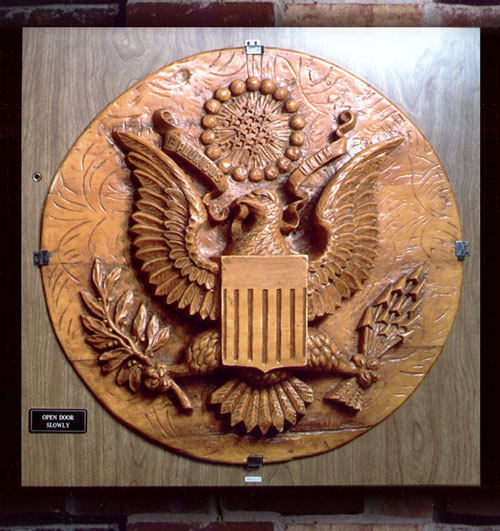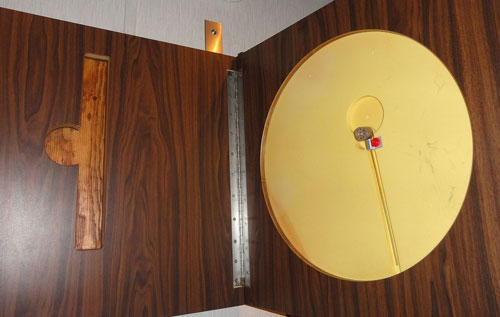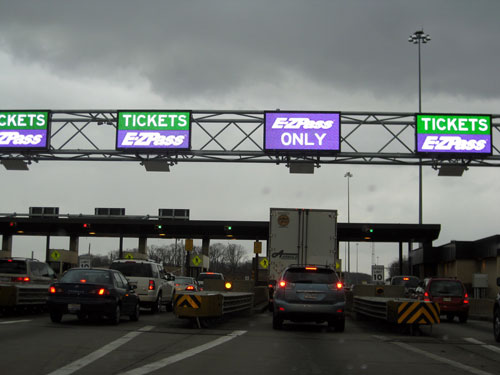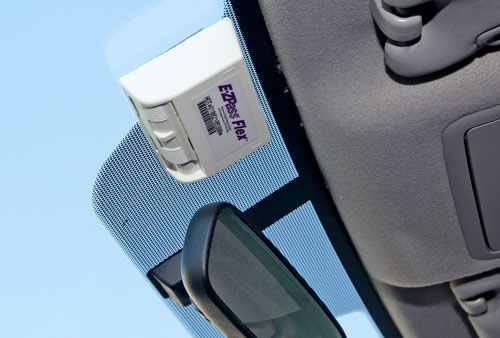Counting All Cars
Pondering the evolution of electronic tolling, the system that doesn’t slow you down even as it charges you to use it. It has roots in the theremin—sorta.
“Highway authorities throughout the country are building futuristic ‘smart-road’ systems designed to unclog traffic and improve driver safety. But these smart roads could lead to an Orwellian surveillance state if we aren’t careful.”
— The introduction to a 1995 New York Times op-ed piece, written by Simson Garfinkel, a technology and security reporter whose name evokes a certain folk-pop duo. Garfinkel’s piece laid out many of the early concerns about electronic tolling systems such as on-the-windshield E-Z Pass, which had just launched in New York, and the under-the-front-bumper E-Pass, which was new to Florida at the time. These systems allow for detailed tracking of when drivers pass through the systems, and Garfinkel’s article noted the potential dangers the technology could create for consumer privacy. “It would create a bank of personal information that the Government and private industry might have difficulty resisting,” Garfinkel warned of the systems.

This presidential seal is hiding something. (Wikimedia Commons)
The earliest example of an RFID device was invented by a spy who also invented a well-known musical instrument
As works of covert espionage go, you can’t do much better than a giant, wooden, handmade U.S. Presidential seal that is designed to sit inside some fancy bureaucrat’s room. It looks like a pretty snazzy gift, a nice decoration fit for a world leader, or at least someone who works for a world leader.
But there was something hiding in that giant wooden eagle, particularly in its beak area, and nobody happened to notice this fact for nearly a decade after its creation.
That something was a novel device invented by Leon Theremin, a Russian man who also invented—you guessed it—the electric guitar. (Kidding!)
Seriously though, Leon Theremin’s work on the theremin took advantage of the way the human body interacted with electric charges to create different kinds of pitch and tone. The instrument remains one of the most unique ever created, and in many ways, the skill used by Theremin to create the musical instrument made him the perfect kind of person to work on eavesdropping devices.
While he spent much of the 1930s in the United States, selling both the theremin and other devices that relied on both radio and electric current, he returned to the Soviet Union just before the outbreak of World War II. Imprisoned during the war, Theremin initially faced the hardships of the Kolyma Gulag, but was eventually transferred to work in Sharashka, the labor camp system’s secret research facility. Naturally, it was a good spot for Theremin, who worked on numerous military projects while there, including the device that became known as the Great Seal bug.
So, back to that Great Seal. Given to U.S. Secretary to the Soviet Union W. Averell Harriman in 1945 by the Soviet Young Pioneers—effectively the Communist take on the Boy Scouts—the seal was hiding an impressive bug inside. Harriman years later would deny that the seal was bugged at the time he received it, though all signs point to the bug being there the entire time.
“I hung it up over the fireplace in my study,” he said in a 1960 Associated Press article. “It was not bugged when I had it.”
The bug, either way, was technically impressive. Rather than simply being something that would be turned on at all times (remember, this was the 1940s, battery-powered devices of this type weren’t really a thing), Theremin’s bug was designed to be passive device that only worked when it detected a specific radio frequency—say, one used when the Soviets were looking to spy on the U.S. Ambassador to the Soviet Union. At that point, it became a full-fledged spy device, with a microphone that picked up what was being said in the room and played it over a radio frequency.

Here’s what it was hiding. (Wikimedia Commons)
As a result of the bug’s passive nature, it’s frequently called the first radio-frequency identification, or RFID, device.
The crazy part about the bug is that it took quite a long time for the Americans to figure out they had been bugged. Evidence of the bug only showed itself in 1952, after George F. Kennan—who only served in the ambassador role for a few months—asked one of his officials do do a sweep for bugs one night while he did some official work. That night, it turned out, Soviet spies activated the bug. It took some looking, but eventually the device was detected by putting a radio receiver next to the device, creating a high-pitched noise as the microphone got close to an audio source, something called the “howl-round principle.”
“The howl-round principle operates by generating an amplified audio signal based on the demodulated radio-frequency signal transmitted by a bug,” authors Graham Brooker and Jairo Gomez wrote in a technical article about the device for IEEE A&E Systems Magazine. “This feedback process produces a high-pitched squeal that can be useful in pinpointing the position of the transmission.”
Despite some differences in the way that modern RFID devices are generally used, Theremin’s device gained a reputation as being an important predecessor of the technology in the years after the technology was formally patented in the 1970s by Mario Cardullo.
In a 2003 article for RFID Journal, Cardullo pointed to surveillance systems, along with another wartime innovation—the use of “friend or foe” transponders on military aircraft—as inspiring his invention. He also, specifically, pointed to the failures of Kartrak, the railroad system’s early take on the barcode, as directly inspiring his work on RFID.
“There were a number of problems with the [Kartrak] system,” he wrote. “One was that the reflectors were easily damaged or vandalized. Dirt and mud would obscure the reflected surface, and there was no way to easily change the data the reflected bar code contained, which limited the usefulness of the system.”
Cardullo, whose investors at the time immediately saw the device’s potential in tollbooth applications but ultimately weren’t able to take advantage of it, was careful to characterize his invention, which relied on changeable memory, as one that built upon other things. And others built upon his work as well, with the first patent using the RFID name, credited to Charles Walton, coming about in 1983.
The RFID tag was one of great versatility, a way to detect information as it went through a central point. It would only be a matter of time before it came to redefine the tollbooth.
1987
The year that the world’s first electronic tollbooth was launched in Ålesund, Norway. The Scandinavian country was an early pioneer of electronic tolling, with one early system, the Trondheim Toll Ring, being primarily designed to use the technology as early as 1991, though the system was eventually shut down in 2005, having raised €215 million over a 14-year period of operation.

The U.S. doesn’t have a national electronic tolling system. E-Z Pass is the closest. (BankBryan/Flickr)
The electronic toll booth has evolved by leaps and bounds over the past few decades, but its greatest barriers remain purely bureaucratic
Around the time that the first electronic toll booths were coming online in the United States, a movie parody perhaps perfectly summed up the problem with old-style toll booths.
Robin Hood: Men in Tights, perhaps the last iconic film directed by Mel Brooks, featured a scene in which Robin Hood (played by Cary Elwes) is trying to cross a bridge, but Little John (Eric Allan Kramer) is standing in his way.
“Sorry, but a toll is a toll, and a roll is a roll, and if we don’t get no tolls, then we don’t eat no rolls. … I made that up,” says Little John.
Toll booths, up until that point in time, worked in this specific way—to move forward, you had to make a payment of some kind, but while the payment was annoying, the true annoyance was the fact that there was a barricade that prevented you from moving forward.
The electronic toll booth couldn’t do anything about the payment (state and local governments need their rolls, after all), but it could help solve the barricade problem, allowing cars to drive through with their transponders—at first with only a short stop, and later without having to stop at all.
It was obvious that something like electronic toll collection was going to come about at some point. Less obvious, at least at first, was that the solution was going to be RFID. In fact, just like with the railroads, there were competing technologies that aimed to solve the tolling problem. One 1990 Asbury Park Press article suggested that “antennas, shortwave air waves, or lasers mounted on toll booths” would be used to solve the problem. The article also featured an interview with the deputy director of the Delaware River Port Authority, who noted that some drivers had already been using laser-scanned stickers on their cars since 1971.
Other companies, meanwhile, were trying to make a case for their vision of the future—with differing levels of ambition. One initiative pushed by the federal government and backed by AT&T was something called Intelligent Vehicle Highway Systems, which aimed to not only automatically collect tolls, but also warn of traffic hazards. A 1992 Asbury Park Press article explained how AT&T’s proposed system would work:
On his way to work, a commuter relies on a small piece of equipment located on the dashboard, called a “transponder.” The transponder communicates via towers planted at various checkpoints, mostly at toll areas and other highway stops.
Perhaps as he is about to get on a major highway, the driver’s transponder alerts him of a traffic jam, giving him enough lead time to take an alternate route.
On the alternate highway, the driver inserts his card into the transponder as he approaches a toll booth. A simple registering of a “click” assures him the transaction has been completed. He will either be billed at the end of the month for all toll transactions or the amount will be deducted from a running balance.
If this sounds like a combination of electronic tolling and Waze, you’d be right.
So no, we didn’t get this, but it clearly inspired what came later. A 1990 film highlighting the technology in action looks like something the federal government would come out with in 1990, but plays out not unlike one of those “You Will” commercials that AT&T produced around 1994—in which the telecom giant mostly predicted the future, but wasn’t actually involved in making it a reality. A variant of IVHS was eventually passed into law in 1992, however, and ended up giving us those computerized signs on freeways that tell us when we should pick an alternate route.

An E-Z Pass Flex transceiver, which can be set to a special carpooling mode when three people are in the vehicle. (VDOT/Flickr)
As for tolling, the technology we got, in most cases, was RFID-based systems like E-Z Pass, along with similar variants such as Illinois’ I-Pass. Now, E-Z Pass is by far the most common such system in North America, but it’s far from the only one. In fact, one of the biggest problems with modern electronic tolling, at least in the U.S., is that many of the various regional tolling systems generally aren’t compatible with one another. Florida’s SunPass, for example, doesn’t talk to E-Z Pass, or the threedifferentsystems used in Texas, or California’s FasTrak. (The three systems in Texas do talk to one another, though, along with the system in Kansas. Confused yet? Of course you are!)
As Wired noted last year, there is actually a law that requires these different systems to eventually talk to one another, but the systems blew the deadline, in part because of a giant system of bureaucratic challenges. Not that most people would notice, anyway. After all, it’s not like you go on a cross-country road trip every other day, do you?
“Unless you are constantly crossing the continent, you’ll never notice once it all comes together,” the magazine’s Nick Stockton wrote “It’ll be a minor annoyance wiped away, like a bug under a soapy wiper.”
(That said, there is a solution to this problem out there. For one, there’s a service called NationalPass that is designed to work with all existing toll networks, including transponders. While it isn’t cheap—at $35 for the transponder itself and fees of between $7.99 and $10.99 per month for use—it did technically fulfill the rules about toll system interoperability in time to meet the law’s requirements. And in the long run, the problem may be moot, as vehicles, such as those made by Audi, start building in RFID technology.)
Electronic toll collection is all about breaking down barricades. Ironically, some of the biggest ones still standing might be between all the different electronic tolling systems.
2019
The year that China will require all new vehicles to include an RFID tag of some kind, something the Chinese government says will be used to track traffic, pollution, and public safety. It does also play into China’s recent push to increase surveillance, however.
The privacy concerns that Simson Garfinkel was quick to mention about electronic toll collection never actually went away, although they’ve perhaps fallen to the wayside due to the sheer utility of electronic tolling. Like social media or advertising-sponsored news, most people only think about the technology in terms of the benefits, not the data it generates.
Occasionally, though, the concerns resurface. In 2013, a hardware hacker named Puking Monkey (great name) decided to modify his E-Z Pass transponder so that it would inform him with flashing lights and a mooing sound whenever it was being used. He then drove around New York City and let the flashing, mooing E-Z Pass do its thing.
As it turns out, despite Times Square not having any tollbooths, Puking Monkey’s transponder generated plenty of activity, which was clearly a pretty surprising finding.
So what was the deal? According to Forbes, the New York Department of Transportation decided at some point to use those transponders to track real-time traffic data throughout the city, despite not disclosing this to E-Z Pass owners. The data, officials emphasized, was anonymized and intended to help improve traffic patterns in the region.
“This technology … allows engineers to identify traffic issues and respond with signal changes,”
NYSDOT spokesman Nicholas Mosquera told Popular Science.
The use of E-Z Pass data has, at times, even gained an element of political scandal. In the years before Bridgegate, former New Jersey Gov. Chris Christie and his staff had used late Sen. Frank Lautenberg’s E-Z Pass data to attack the Democratic senator for failing to pay tolls (and, perhaps, spending too much time in New York City). Only after the Bridgegate scandal hit did anyone think to look at the situation and figure out whether sharing or even accessing that data was actually legal without a court order. Turns out, it wasn’t.
Perhaps it’s for this reason, among others, that you can actually find people selling devices that detect hidden E-Z Pass transponders.
I’m not saying we should necessarily be paranoid about the E-Z Pass or other forms of electronic tolling—especially as they’re essentially required in some states—but maybe we should think about what it represents a little more.
These questions, there since the beginning, shouldn’t pass us by.
Editor’s note: This story has been updated with some additional details about NationalPass, a system that allows drivers to use the same transponder around the country.
:format(jpeg)/uploads/tedium110818.gif)
/uploads/tedium110818.gif)

/uploads/ernie_crop.jpg)